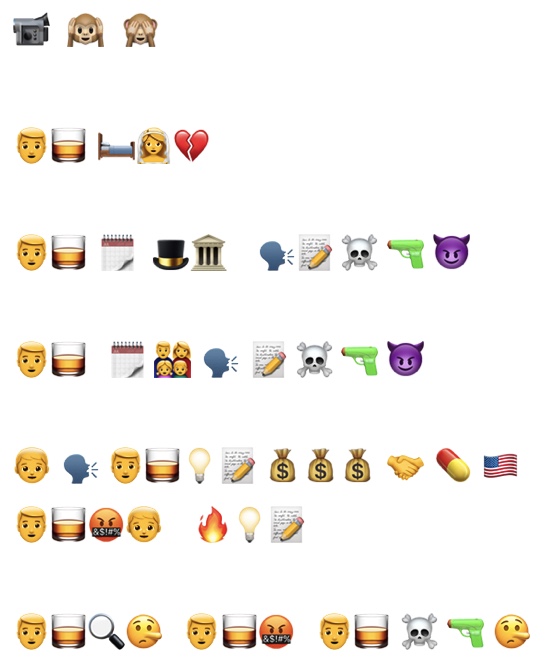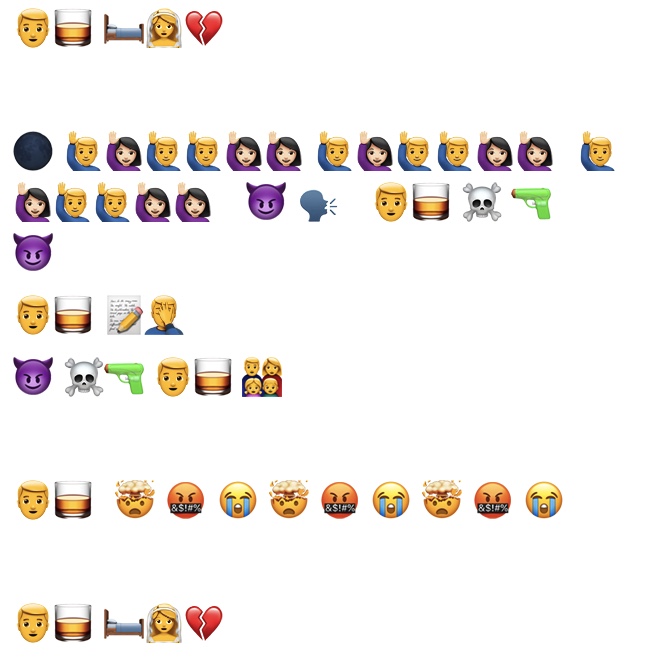Here is my emoji story. I hope you enjoy it!


This was a fun assignment! I tend to rely on a limited number of emojis, so it was fun to see all of the different possibilities! I found it interesting that to complete this task I still started with a written summary of the key points I wanted to include in my emoji story. I needed to see the words on the paper in order to have a clear vision of where to go with this task.
Once I had summarized the plot, I went through the list of emojis and just copied and pasted the ones I thought might be useful based on the plot events I had highlighted. I then decided on the emojis for the title, since I felt this would be critical to understanding my story. Without context I think it would be next to impossible to interpret this story! The rest of the process was fairly easy, although I kept going back to replace emojis with ones I thought represented the message better. I definitely picked a show I thought most people would be familiar with, as I recognized that trying to decode the plot summaries would be a challenging task.
As I constructed my story, I found I didn’t rely on syllables, but instead selected symbols for key characters and plot events so I could provide a general summary rather than a literal translation. To me this indicates that while digital images may remediate the way text is used, it cannot be completely replaced. This reminded me of Bolter’s (2001) prediction that synchronous and asynchronous video would one day replace standard email, and as a result “verbal text will be further marginalized in the quest for immediacy” (p.74). The majority of emails I compose and read are still primarily based in prose text, which is just one example of how different modes of representing ideas won’t necessarily lead to replacing all aspects of traditional communication.
Using the emojis to tell this story also demonstrates that while the printed text continues to have an important role in communication, it exists in a remediated form in so many contexts. This trend is represented in Bolter’s (2001) discussion of how textbooks have evolved over the last several decades. Current textbooks rely on multimedia – images, links, symbols, and a variety of other textual features to highlight key information. This is in stark contrast to older textbooks that were primarily printed text with a minimum number of other features.
Ultimately, this assignment showed me that while printed text is still a primary form of communication, the multimodal nature of text is incredibly influential. Bolter (2001) emphasizes the need to engage with these new forms of media rather than be influenced by the perspective that these changes will lead to poor writing skills and weaker communication. Even so, it is unlikely that emojis and other forms of multimodal text will completely replace traditional writing. Writing has withstood the test of time. The printed text continues to drive communication even while existing in a remediated form in so many media contexts.
References:
Bolter, J. D. (2001). Writing space: Computers, hypertext, and the remediation of print (2nd ed.). Mahwah, N.J: Lawrence Erlbaum Associates. doi:10.4324/9781410600110

Hi Helen,
I cannot get this one! At first, just looking at the title I thought maybe The Quiet Place, or See no Evil Hear no Evil, but then the plot didn’t make sense. So I looked at the plot and saw the repetition of the man who drinks who at one point a younger man speaks to him about an idea he has to make money by possibly selling drugs to America? But the title really kept throwing any idea I had about the plot! I’ll have to come back later and see if anyone gets this one! 🙂 Well done!
You are so close!! The main character drinks OFTEN and yes a younger man does make this proposition. I’m impressed! It might help to know it is an episode of a show and not a movie. I should have thought of a way to communicate that in the title. Perhaps that hint might help!
Hi Helen, I have to admit that like Sasha you have me stumped! Honestly, this is probably because I haven’t seen this show though. When I saw the monkeys in the title, I also thought about See No Evil, Hear no Evil but that’s just probably due to the fact that the set of three monkeys often convey this message. I picked up on snippets on clues throughout the plot though like for e.g. I think the drinking man is investigated at some point for lying… Am I right about that? What’s been interesting for me in this task is how often I have changed my way of reading from the normal left to right convention to trying the combination of emojis going right to left when my first interpretation doesn’t make sense. Am I the only one doing this?
Hi Carla,
I definitely think the title is throwing people off since there is such a common meaning associated with the monkeys. I should have picked something without an existing meaning, which is actually interesting in the context of this assignment. When using images we have to be aware of how they are much more open to interpretation than text, and those interpretations can be culturally influenced. As students construct meaning they are relying on a lived experience we may know nothing about. I also think I’ve been reading way too much about constructivism in my other course! Your guess is a little off…the drinking man finds out someone he trusted has betrayed him (hence the pinocchio nose). Hopefully I can reveal the plot soon!
Hi Helen,
I can’t figure it out either. I agree I also assumed something along the lines of see no evil, hear no evil. It really shows how easily and strongly a meaning can become associated with a symbol based on usage, and then it becomes very difficult to interpret other meanings from it. I’m having trouble imagining this seemingly very complicated plot being a single episode of TV!